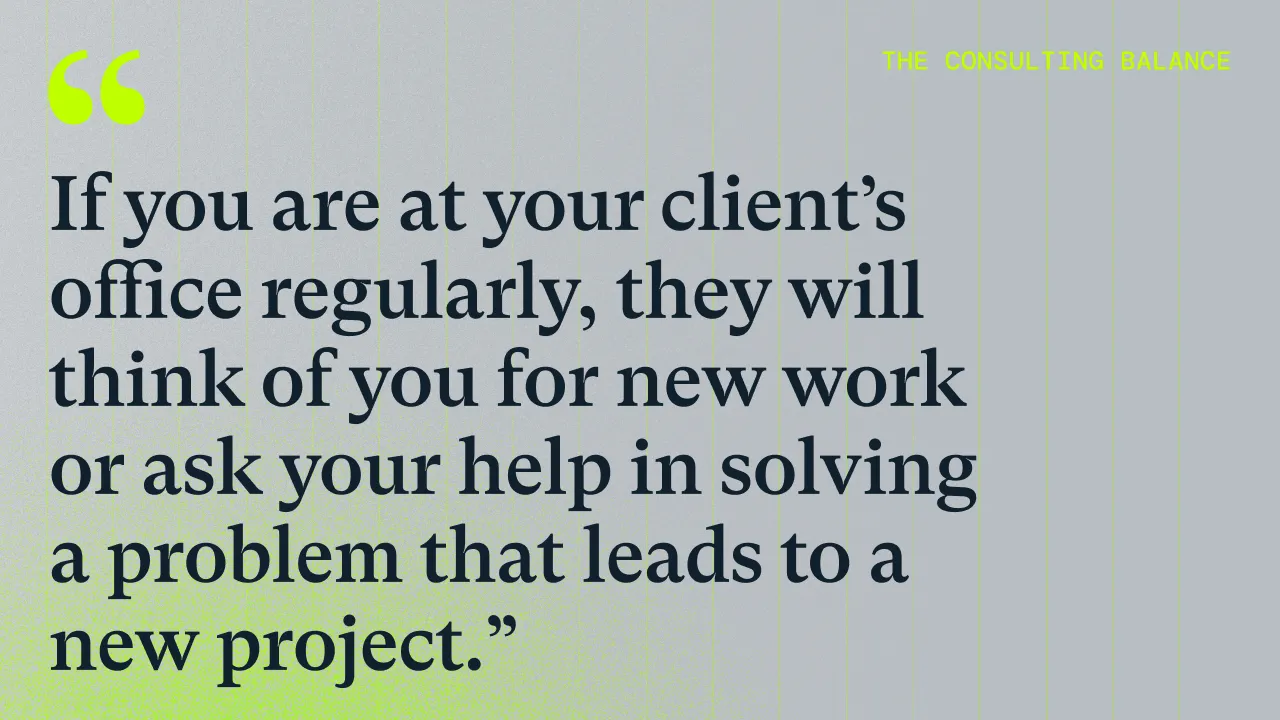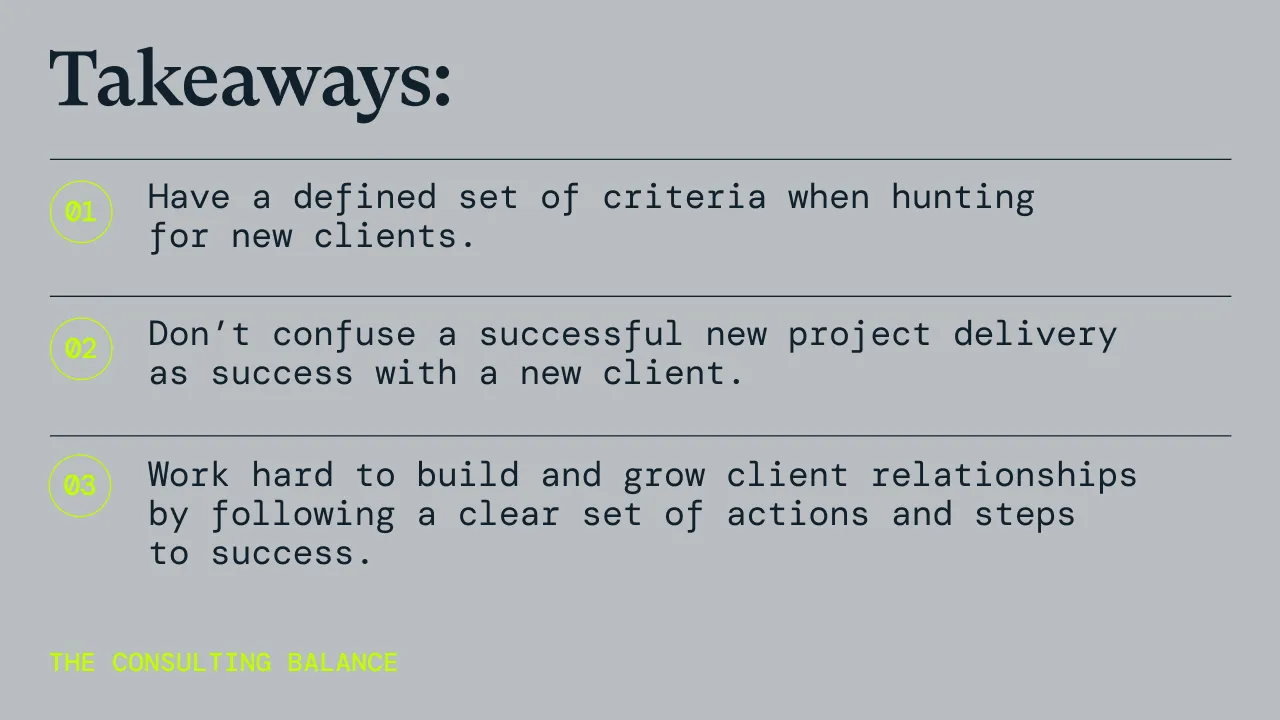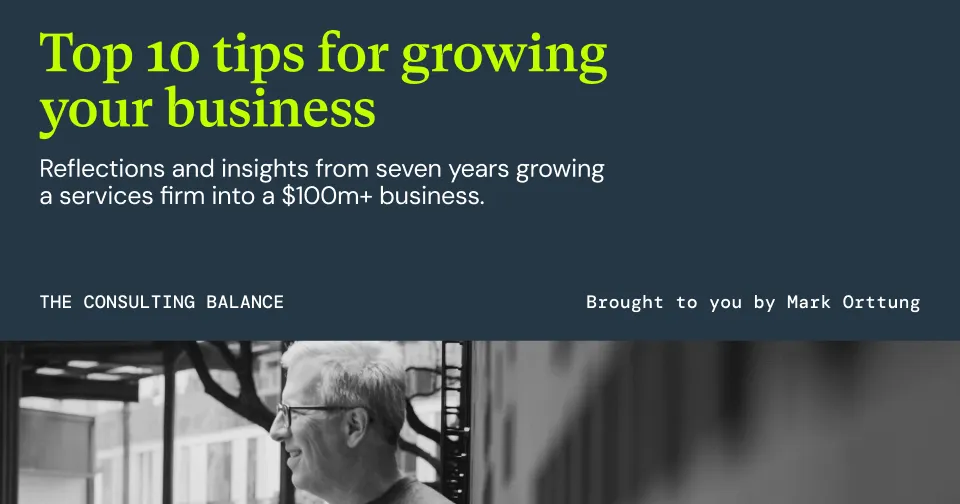Top 12 tips for building lasting client relationships

Mark describes how he secured $10m clients over three clear phases.
In this article you will learn how Mark grew a handful of $5m clients to $10m relationships by following a simple hourglass plan. At the top of the hourglass, the hunting phase qualified leads and defined projects to the point of proposal.
The middle of the hourglass, or pilot phase, was when a new client project would be delivered, setting the tone for whether an ongoing relationship would be established.
At the bottom of the hourglass was the farming phase, when a lot of hard work went into building, expanding and growing clients. In this phase you’ll learn twelve game-changing tips on how to make this happen.
Everything you need to know about building lasting client relationships
“We’ll give you a small, complex project to prove yourselves. If your team does well, I’ll introduce you to my colleagues across the company. If you don’t deliver, I’ll make sure you never work here again.”
That was how our first buyer at a Fortune 500 retailer framed the challenge he was offering us. It was brutal, but in a way I appreciated the clarity of the situation. Almost all of our new clients started off this way in 2019. He was just the only one to say it out loud. But they all thought something similar.
To make matters worse, this project we’d been given to prove ourselves was one that had already been attempted (and failed) by other consultancies. And this was not unusual for us. We were a relatively small, unknown firm, so this was how we'd have to break into Fortune 500 clients until we were more established.
It took me a while to really understand what was needed to find, acquire, and grow enterprise clients. This pilot phase was always exciting because it was the culmination of the hunting phase of our process. As we got more of these pilots, I quickly realized that there is a difference between successful project delivery and new client success. Every successful delivery was only a beginning to what would hopefully become solid, successful, ongoing relationships.
How to build clients in one simple diagram
I like trying to boil complex processes down to a simple picture whenever I can. In this case, someone described our challenge as an hourglass shape. The idea was that we’d have a typical sales funnel for the hunting phase of our new client acquisition process, the middle part of the hourglass would be our pilot phase and the bottom part our farming phase.

What is the hunting phase?
This phase in the funnel would be broken into three stages:
- Qualified Leads - At the top of our pipeline, we would try to identify a large number of prospective new clients qualified to buy from us. For us, this typically meant that they had a budget for custom application development that was more than $10 million per year. We found that this disqualified many companies in the manufacturing space because they used almost entirely off-the-shelf software.
- Defined projects - To get to the next level of our pipeline, prospects needed to have a project coming up that fit our model. Ideally, a customer-facing system that needed to be custom software with a budget of at least $500k.
- Proposals - The last step of our hunting pipeline was where we had made a proposal.
The pilot phase
If we executed our hunting phase well, we’d get ourselves into one of these do or die pilot projects - the middle of the hourglass. While they were a great step, we really needed to develop a stable of clients who were long-term, with annual billings of $5m or $10m (depending on where they sat in our funnel).
It took a whole lot more work to get from successfully implementing a pilot to building that kind of value with a client, not to mention the strong relationships needed to manage it. If we were lucky enough to be given such an opportunity, we were then in the farming phase.
What is the farming phase?
You can see in the diagram, that we broke this farming phase into three “buckets”, based on results:
- Build - These were the clients where we’d successfully delivered a first project and had credibility to bid on further work. The vast majority of our clients resided in this bucket and we spent a huge amount of energy trying to get them to the next step.
- Expand - This set of clients had a team of 25 or more people servicing each. In our world, this was effectively a client where we were billing at least $5m per year. It would typically take 3-4 years with a client (from when we first started working with them) to get them to this point. After some time we managed to get a few to here within two years.
- Grow - These were our best clients, with more than 50 people billing. This would equate to approximately $10m per year in revenue for us. In the early days, we had nobody in this category, but it was a great goal to shoot for. It eventually took us 5+ years with a client to get them into this bucket. We were always looking for a way to shorten that to fewer years, but the fastest we ever did was four years.

12 key insights into growing with your clients
We developed a number of techniques for building our relationships with clients to be able to earn our way into the Expand or Grow buckets with them. I’ll list the most valuable here with more detail on each further down:
- Have a practitioner who can sell and lead the team
- Pair your team with the client team
- Build relationships as high in the org as you can
- Understand what success is for the client team
- Understand success for individuals at the client
- Walk the halls
- Build a proactive account plan
- Run QBRs with as senior a team as possible
- Push the client for business outcome-based goals
- Understand the client’s road map and budget
- Make proactive proposals
- Invest in team-building with the client

1. Have a practitioner who can sell and lead the team
Our buyers wanted to work with and buy from people who could also build great software and go to the whiteboard to help them think through a problem. For us, this meant we had to have practitioners leading the project who were willing to do the selling to farm the account.
2. Pair your team with the client team
We would explicitly work with our team to figure out who on the client side they best matched up with, both for what they were working on and who they got along with. One of our leaders called this their “work BFFs”, the purpose being to build close relationships so that the client would trust them to help solve problems.
3. Build relationships as high in the org as you can
We would often be working for a buyer in an organization that was somewhere down the org chart. It felt uncomfortable to try to build relationships with their bosses, but it was necessary to grow our presence. Most of our buyers would support us in doing this and make introductions for us.
4. Understand what success is for the client team
It is always critical to really know what metrics the team buying from us would be measured on. It may be that our project that lasted a year could be at risk if they didn’t meet some unrelated goals. It was our job to know that and potentially step in to help with those goals to keep them in good standing in the client company.
5. Understand success for individuals at the client
One of the most powerful things for us was understanding how our buyer was measured. What did they have to do to get their quarterly or annual bonus? The more we understood this, the more we could help them hit their goals.
6. Walk the halls
It’s one of the oldest techniques in consulting, but it’s amazing how often people neglect to do this. Human nature is such that if you are at your client’s office regularly, they will think of you for new work or ask your help in solving a problem that leads to a new project. This became more difficult as more people worked from home, but we’d still work to find ways to meet in person regularly (lunch or dinner was often welcomed by clients who spent the day working from home).
7. Build a proactive account plan
We had a template and a formal process for building account plans. These included knowing things like the client’s overall goals, recent results and news. We’d also map out the organization and figure out whether people on the chart were positive, neutral, or negative on us. We’d actively work to move more and more to the positive view.
8. Run QBRs with as senior a team as possible
A great way to get the attention of more senior people is to run a quarterly business review (QBR). If these are focused on the right goals, they can be powerful for making our buyer look good in front of their bosses. They are also a good way to make sure we were communicating the challenges that inevitably come with complex work, getting clients to buy into how we’d address the challenges.
9. Push the client for business outcome-based goals
Most clients were not crisp in defining their goals in pure business terms. For example, “grow revenue by 10% for this product line,” or “increase the conversion rate by 10% for this website.” Even if our project wasn’t defined in these terms, we’d try to get the client to reframe them so that we could make sure we were delivering value.
10. Understand the client’s road map and budget
Our best clients would share their annual road map with us so that we could help them make a plan for how to deliver it. Seeing this road map would almost always give us visibility into other projects we could help with too.
11. Make proactive proposals
We’d ask our teams to think about problems at the client and make unsolicited proposals to them. They weren’t always successful, but they almost always led to conversations with the client that would ultimately end up with us getting more work.
12. Invest in team-building with the client
It always seemed extravagant, but we’d figure out what kinds of events the client liked and sponsor team events. We did sporting events, comedy, live theater, and lots of happy hours and dinners. The level of relationship building we could do was worth all of the expense.
These are some of the techniques that moved things forward the most, but we had lots of others too. It took a ton of effort to get clients into the Expand and Grow buckets, but that is what allowed us to grow Nexient at such a rapid clip for five years running.
What I learned
1. Before submitting a new client proposal with a prospect, ensure they fall within a defined set of criteria, created to ensure your business thrives. This could be their annual budget for implementing solutions orientated to your service. It might also be whether they have any projects coming up that your service can deliver on.
2. Delivering a new client project is the tip of the iceberg. The real hard work starts after this point.
3. Make a thorough checklist of everything you can possibly do to build, expand and grow with your client. This includes building relationships as high in the org as you can, understanding what success looks like for the client and individuals at the client, regularly being onsite and ensuring you have some business outcome-based goals to follow.

.webp)

.webp)
